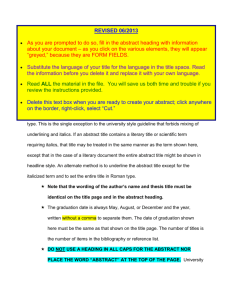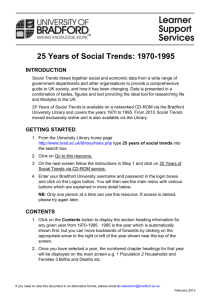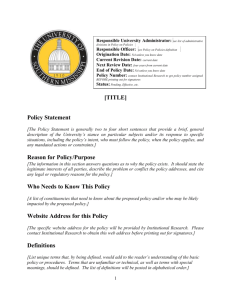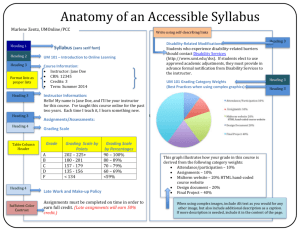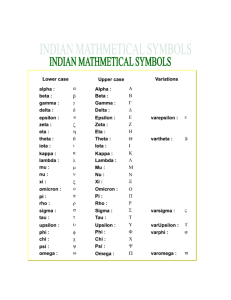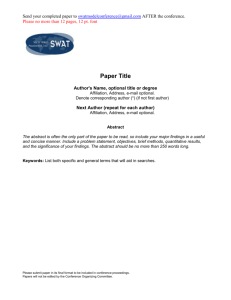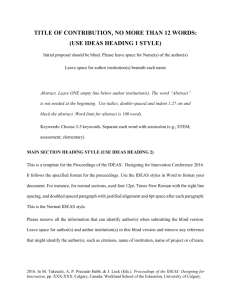Full Paper Template for Review Process
advertisement
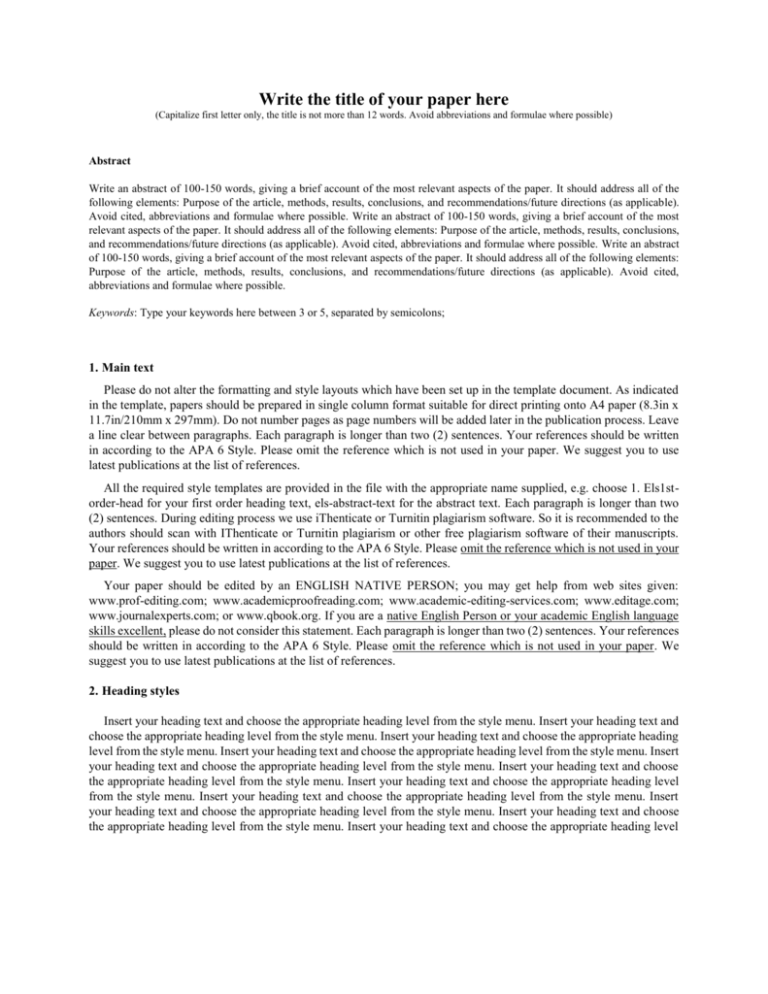
Write the title of your paper here (Capitalize first letter only, the title is not more than 12 words. Avoid abbreviations and formulae where possible) Abstract Write an abstract of 100-150 words, giving a brief account of the most relevant aspects of the paper. It should address all of the following elements: Purpose of the article, methods, results, conclusions, and recommendations/future directions (as applicable). Avoid cited, abbreviations and formulae where possible. Write an abstract of 100-150 words, giving a brief account of the most relevant aspects of the paper. It should address all of the following elements: Purpose of the article, methods, results, conclusions, and recommendations/future directions (as applicable). Avoid cited, abbreviations and formulae where possible. Write an abstract of 100-150 words, giving a brief account of the most relevant aspects of the paper. It should address all of the following elements: Purpose of the article, methods, results, conclusions, and recommendations/future directions (as applicable). Avoid cited, abbreviations and formulae where possible. Keywords: Type your keywords here between 3 or 5, separated by semicolons; 1. Main text Please do not alter the formatting and style layouts which have been set up in the template document. As indicated in the template, papers should be prepared in single column format suitable for direct printing onto A4 paper (8.3in x 11.7in/210mm x 297mm). Do not number pages as page numbers will be added later in the publication process. Leave a line clear between paragraphs. Each paragraph is longer than two (2) sentences. Your references should be written in according to the APA 6 Style. Please omit the reference which is not used in your paper. We suggest you to use latest publications at the list of references. All the required style templates are provided in the file with the appropriate name supplied, e.g. choose 1. Els1storder-head for your first order heading text, els-abstract-text for the abstract text. Each paragraph is longer than two (2) sentences. During editing process we use iThenticate or Turnitin plagiarism software. So it is recommended to the authors should scan with IThenticate or Turnitin plagiarism or other free plagiarism software of their manuscripts. Your references should be written in according to the APA 6 Style. Please omit the reference which is not used in your paper. We suggest you to use latest publications at the list of references. Your paper should be edited by an ENGLISH NATIVE PERSON; you may get help from web sites given: www.prof-editing.com; www.academicproofreading.com; www.academic-editing-services.com; www.editage.com; www.journalexperts.com; or www.qbook.org. If you are a native English Person or your academic English language skills excellent, please do not consider this statement. Each paragraph is longer than two (2) sentences. Your references should be written in according to the APA 6 Style. Please omit the reference which is not used in your paper. We suggest you to use latest publications at the list of references. 2. Heading styles Insert your heading text and choose the appropriate heading level from the style menu. Insert your heading text and choose the appropriate heading level from the style menu. Insert your heading text and choose the appropriate heading level from the style menu. Insert your heading text and choose the appropriate heading level from the style menu. Insert your heading text and choose the appropriate heading level from the style menu. Insert your heading text and choose the appropriate heading level from the style menu. Insert your heading text and choose the appropriate heading level from the style menu. Insert your heading text and choose the appropriate heading level from the style menu. Insert your heading text and choose the appropriate heading level from the style menu. Insert your heading text and choose the appropriate heading level from the style menu. Insert your heading text and choose the appropriate heading level from the style menu. Insert your heading text and choose the appropriate heading level from the style menu. Insert your heading text and choose the appropriate heading level from the style menu. 2.1. Second order head Insert your heading text and choose the appropriate heading level from the style menu. Insert your heading text and choose the appropriate heading level from the style menu. Insert your heading text and choose the appropriate heading level from the style menu. Insert your heading text and choose the appropriate heading level from the style menu. Insert your heading text and choose the appropriate heading level from the style menu. Insert your heading text and choose the appropriate heading level from the style menu. 2.1.1. Third order head Insert your heading text and choose the appropriate heading level from the style menu. Insert your heading text and choose the appropriate heading level from the style menu. Insert your heading text and choose the appropriate heading level from the style menu. Insert your heading text and choose the appropriate heading level from the style menu. Insert your heading text and choose the appropriate heading level from the style menu. Insert your heading text and choose the appropriate heading level from the style menu. 2.1.1.1. Fourth order head Insert your heading text and choose the appropriate heading level from the style menu. Insert your heading text and choose the appropriate heading level from the style menu. Insert your heading text and choose the appropriate heading level from the style menu. Insert your heading text and choose the appropriate heading level from the style menu. Insert your heading text and choose the appropriate heading level from the style menu. Insert your heading text and choose the appropriate heading level from the style menu. 3. Tables All tables should be numbered with Arabic numerals. Headings should be placed above tables, underlined and centred. Leave one line space between the heading and the table. Only horizontal lines should be used within a table, to distinguish the column headings from the body of the table. Tables must be embedded into the text and not supplied separately. Table 1. Name of the table Groups Control Group Experimental Group 1 Experimental Group 2 Pre-Test 21 38 28 Post-Test 36 28 45 Pre-Test Mean 22.47 25.67 33.46 Post-Test Mean 22.59 38.19 31.85 All tables should be numbered with Arabic numerals. Headings should be placed above tables, underlined and centred. Leave one line space between the heading and the table. Only horizontal lines should be used within a table, to distinguish the column headings from the body of the table. Tables must be embedded into the text and not supplied separately. All tables should be numbered with Arabic numerals. Headings should be placed above tables, underlined and centred. Leave one line space between the heading and the table. Only horizontal lines should be used within a table, to distinguish the column headings from the body of the table. Tables must be embedded into the text and not supplied separately. All tables should be numbered with Arabic numerals. Headings should be placed above tables, underlined and centred. Leave one line space between the heading and the table. Only horizontal lines should be used within a table, to distinguish the column headings from the body of the table. Tables must be embedded into the text and not supplied separately. All tables should be numbered with Arabic numerals. Headings should be placed above tables, underlined and centred. Leave one line space between the heading and the table. Only horizontal lines should be used within a table, to distinguish the column headings from the body of the table. Tables must be embedded into the text and not supplied separately. 4. Figures All figures should be numbered with Arabic numerals (1, 2,..., n). All photographs, schemas, graphs and diagrams are to be referred to as figures. Line drawings should be good quality scans or true electronic output. Low-quality scans are not acceptable. Figures must be embedded into the text and not supplied separately. Lettering and symbols should be clearly defined either in the caption or in a legend provided as part of the figure. Figures should be placed at the top or bottom of a column wherever possible, and as close as possible to the first reference to them in the paper. Leave one line space between the heading and the figure. All figures should be numbered with Arabic numerals (1, 2,..., n). All photographs, schemas, graphs and diagrams are to be referred to as figures. Line drawings should be good quality scans or true electronic output. Low-quality scans are not acceptable. Figures must be embedded into the text and not supplied separately. Lettering and symbols should be clearly defined either in the caption or in a legend provided as part of the figure. Figures should be placed at the top or bottom of a column wherever possible, and as close as possible to the first reference to them in the paper. Leave one line space between the heading and the figure. The figure number and caption should be typed below the illustration and left justified. ENSURE THAT ALL THE FIGURES ARE OF 300 DPI RESOLUTIONS TO ENSURE GOOD OUTPUT. Verbal Context Basic condition 1: Verbal Text as an Auditory Stimulus Decoding/Predicting Basic Condition 2: Listener as an active receiver Content Schema Formal Schema Linguistic Schema Figure 1. Name of the figure All figures should be numbered with Arabic numerals (1, 2, ., ., n). All photographs, schemas, graphs and diagrams are to be referred to as figures. Line drawings should be good quality scans or true electronic output. Lowquality scans are not acceptable. Figures must be embedded into the text and not supplied separately. Lettering and symbols should be clearly defined either in the caption or in a legend provided as part of the figure. Figures should be placed at the top or bottom of a column wherever possible, and as close as possible to the first reference to them in the paper. Leave one line space between the heading and the figure. ENSURE THAT ALL THE FIGURES ARE OF 300 DPI RESOLUTIONS TO ENSURE GOOD OUTPUT. All figures should be numbered with Arabic numerals (1, 2,..., n). All photographs, schemas, graphs and diagrams are to be referred to as figures. Line drawings should be good quality scans or true electronic output. Lowquality scans are not acceptable. Figures must be embedded into the text and not supplied separately. ENSURE THAT ALL THE FIGURES ARE OF 300 DPI RESOLUTIONS TO ENSURE GOOD OUTPUT. Lettering and symbols should be clearly defined either in the caption or in a legend provided as part of the figure. Figures should be placed at the top or bottom of a column wherever possible, and as close as possible to the first reference to them in the paper. Leave one line space between the heading and the figure. ENSURE THAT ALL THE FIGURES ARE OF 300 DPI RESOLUTIONS TO ENSURE GOOD OUTPUT. Figure 2. Name of the figure All figures should be numbered with Arabic numerals (1, 2,..., n). All photographs, schemas, graphs and diagrams are to be referred to as figures. Line drawings should be good quality scans or true electronic output. Low-quality scans are not acceptable. Figures must be embedded into the text and not supplied separately. Lettering and symbols should be clearly defined either in the caption or in a legend provided as part of the figure. Figures should be placed at the top or bottom of a column wherever possible, and as close as possible to the first reference to them in the paper. Leave one line space between the heading and the figure. ENSURE THAT ALL THE FIGURES ARE OF 300 DPI RESOLUTIONS TO ENSURE GOOD OUTPUT. References (Your references should be written in according to the APA 6 Style. Please omit the reference which is not used in your paper. We suggest you to use latest publications at the list of references) Van der Geer, J., Hanraads, J. A. J., & Lupton R. A. (2000). The art of writing a scientific article. Journal of Scientific Communications, 163, 5159. Strunk, W., Jr., & White, E. B. (1979). The elements of style. (3rd ed.). New York: Macmillan, (Chapter 4). Mettam, G. R., & Adams, L. B. (1994). How to prepare an electronic version of your article. In B. S. Jones, & R. Z. Smith (Eds.), Introduction to the electronic age (pp. 281-304). New York: E-Publishing Inc. Van der Geer, J., Hanraads, J. A. J., & Lupton R. A. (2000). The art of writing a scientific article. Journal of Scientific Communications, 163, 5159. Strunk, W., Jr., & White, E. B. (1979). The elements of style. (3rd ed.). New York: Macmillan, (Chapter 4). Mettam, G. R., & Adams, L. B. (1994). How to prepare an electronic version of your article. In B. S. Jones, & R. Z. Smith (Eds.), Introduction to the electronic age (pp. 281-304). New York: E-Publishing Inc. Van der Geer, J., Hanraads, J. A. J., & Lupton R. A. (2000). The art of writing a scientific article. Journal of Scientific Communications, 163, 5159. Strunk, W., Jr., & White, E. B. (1979). The elements of style. (3rd ed.). New York: Macmillan, (Chapter 4). Mettam, G. R., & Adams, L. B. (1994). How to prepare an electronic version of your article. In B. S. Jones, & R. Z. Smith (Eds.), Introduction to the electronic age (pp. 281-304). New York: E-Publishing Inc. Van der Geer, J., Hanraads, J. A. J., & Lupton R. A. (2000). The art of writing a scientific article. Journal of Scientific Communications, 163, 5159. Strunk, W., Jr., & White, E. B. (1979). The elements of style. (3rd ed.). New York: Macmillan, (Chapter 4). Mettam, G. R., & Adams, L. B. (1994). How to prepare an electronic version of your article. In B. S. Jones, & R. Z. Smith (Eds.), Introduction to the electronic age (pp. 281-304). New York: E-Publishing Inc. Van der Geer, J., Hanraads, J. A. J., & Lupton R. A. (2000). The art of writing a scientific article. Journal of Scientific Communications, 163, 5159. Strunk, W., Jr., & White, E. B. (1979). The elements of style. (3rd ed.). New York: Macmillan, (Chapter 4). Mettam, G. R., & Adams, L. B. (1994). How to prepare an electronic version of your article. In B. S. Jones, & R. Z. Smith (Eds.), Introduction to the electronic age (pp. 281-304). New York: E-Publishing Inc. Van der Geer, J., Hanraads, J. A. J., & Lupton R. A. (2000). The art of writing a scientific article. Journal of Scientific Communications, 163, 5159. Strunk, W., Jr., & White, E. B. (1979). The elements of style. (3rd ed.). New York: Macmillan, (Chapter 4). Mettam, G. R., & Adams, L. B. (1994). How to prepare an electronic version of your article. In B. S. Jones, & R. Z. Smith (Eds.), Introduction to the electronic age (pp. 281-304). New York: E-Publishing Inc. Van der Geer, J., Hanraads, J. A. J., & Lupton R. A. (2000). The art of writing a scientific article. Journal of Scientific Communications, 163, 5159. Strunk, W., Jr., & White, E. B. (1979). The elements of style. (3rd ed.). New York: Macmillan, (Chapter 4). Mettam, G. R., & Adams, L. B. (1994). How to prepare an electronic version of your article. In B. S. Jones, & R. Z. Smith (Eds.), Introduction to the electronic age (pp. 281-304). New York: E-Publishing Inc. Van der Geer, J., Hanraads, J. A. J., & Lupton R. A. (2000). The art of writing a scientific article. Journal of Scientific Communications, 163, 5159. Strunk, W., Jr., & White, E. B. (1979). The elements of style. (3rd ed.). New York: Macmillan, (Chapter 4). Mettam, G. R., & Adams, L. B. (1994). How to prepare an electronic version of your article. In B. S. Jones, & R. Z. Smith (Eds.), Introduction to the electronic age (pp. 281-304). New York: E-Publishing Inc.


